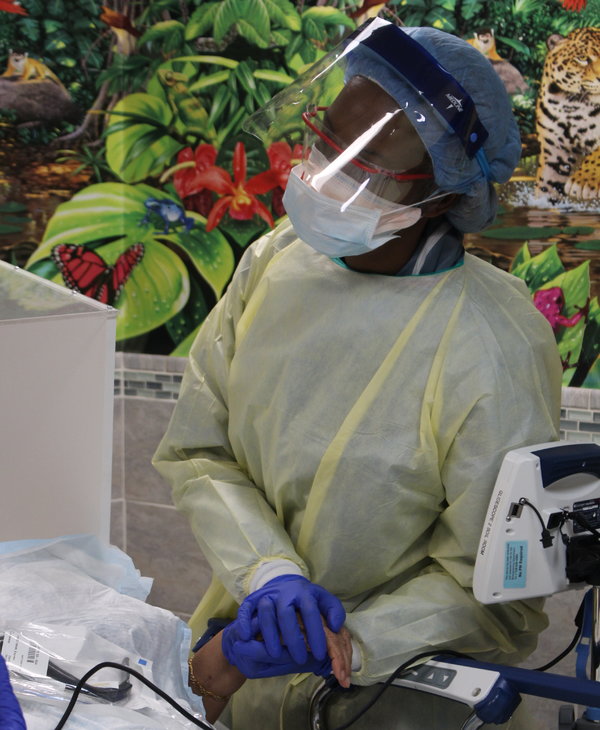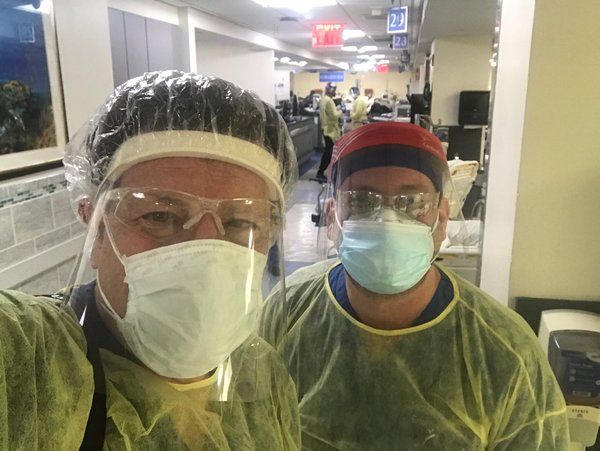April 14, 2020
My look inside the 'hot zone' in NYC hospitals

Originally published on April 14, 2020 in Nicholas Kristof’s weekly New York Times newsletter
Hospitals have been very reluctant to allow journalists in to report, in part because of genuine concerns about infection risk and HIPAA privacy rules. But this pandemic is a story that is best covered not from White House press briefings but from the front lines in the hospitals. I asked many hospitals for permission, and two did agree to let me and a video journalist inside. My column today, with a powerful video on top, shares what we found.
The visit left me deeply impressed by the doctors, nurses, technicians, respiratory therapists and cleaners who risk their lives by working each day in the “hot zone” where contagion spreads. Many confided their fears of getting sick and dying, or their worries about getting loved ones sick, and some spoke of their nightmares and panic attacks. Yet they soldier on with tremendous compassion.
Ventilators aren’t working very well (up to four out of five Covid-19 patients on ventilators in New York City are dying), but I was deeply impressed by something low-tech: the hand-holding. Doctors and nurses are harried and scared, but they take the time to hold patients’ hands. It’s a terrifying time for patients, who are not allowed to have loved ones with them, and this is a gesture of empathy and shared humanity that is moving to witness.

I begin and end the column with Dr. Nicole Del Valle, who spends the day reassuring patients, holding their hands, intubating them, fighting for their lives — and then she goes back home and cries. Her plea to all of the rest of us: “Stay home.”
In the column I link to several organizations that are supporting the hospitals and their staff, including one called Goggles for Docs. I was surprised to see hospital staff in the emergency department wearing ski masks, but it turned out that these were donated by skiers — and they work really well. On my Instagram page, I have shared some images and videos from hospital staff. And here’s the column; please do read.
When Polarization Makes it Harder to Save Lives
A new academic study finds that compliance with social distancing orders depends on political beliefs. In other words, ideology gets in the way of saving lives; I find this a sad reflection of our times. Here’s the paper’s summary:
Social distancing is vital to mitigate the spread of the novel coronavirus. We use geolocation data to document that political beliefs present a significant limitation to the effectiveness of state-level social distancing orders. Residents in Republican counties are less likely to completely stay at home after a state order has been implemented relative to those in Democratic counties. We also find that Democrats are less likely to respond to a state-level order when it is issued by a Republican governor relative to one issued by a Democratic governor …. We conclude that bipartisan support is essential to maximize the effectiveness of social distancing orders.
It’s Time for Broadband for All
Rural parts of America like my hometown of Yamhill, Ore., were transformed in the 1930s and 1940s by rural electrification. Productivity shot up. Today we need a modern equivalent: Bandwidth for all.
I think of that because so many schools are closed, with students meant to attend online classes. But three in 10 low-income Americans don’t have a smartphone, and four in 10 don’t have either home broadband or a computer, according to Pew Research Center. I hope Congress or the next president will come up with a proposal for bandwidth for all to address this — and in the meantime, thanks to groups like Reading Partners for working with disadvantaged children during this crisis to help compensate for closed schools.
How to Rebuild a Post-Covid-19 America
The Times has launched a project looking at inequality, how it shapes the impact of this virus, and how we can rebuild the country afterward. I commend to you a piece by my colleague David Leonhardt and Yaryna Serkez that uses charts to explore American inequality. More articles in the project are here.
If we needed any reminder of these structural inequities, it came in an article from Reuters that described how a Wall Street firm told wealthy investors that it could get them returns of up to 175 percent by taking advantage of federal government programs meant to aid desperate people hurt by the coronavirus. I worry, with President Trump strongly resisting oversight, that a good chunk of the federal aid package will go to plutocrats rather than to millions of desperately needy families.
Mothers’ Day Movement
Every Mother’s Day, I donate to an organization in honor of my wife, mother and mother-in-law. An organization called Mother’s Day Movement tries to nurture that practice: It helps you honor individual mothers by saving the lives of mothers worldwide.
Every year, Mothers’ Day Movement chooses a different organization to channel donations to. This year it has just chosen its recipient — Circle of Health International, known as COHI, which works with mothers and their communities to support health in times of crisis. You can find out more at www.mothersdaymovement.org.
Health Workers Are Our Heroes

Dr. Michael Jones showing me around the “hot zone” of the Jack D. Weiler hospital in the Bronx.
And here’s my column about health workers. I’m very grateful to the Jack D. Weiler Hospital and the Montefiore Moses hospital for letting me into their emergency departments to bear witness to the courage so many medical workers show on a daily basis. I owe a great deal as well to doctors and nurses for speaking very candidly with me about their own fears and frustrations. And I hope that we’ll listen to their advice and stay home and protect ourselves — and thus them as well. Here’s what I found in the “hot zone.”
|
You can connect with me on Facebook or Instagram. If you have friends who might enjoy this newsletter, please forward this email or tell them they can sign up here. If you’re looking for more, check out our recent book here. Feedback and suggestions welcome at kristof-newsletter@nytimes.com. |










